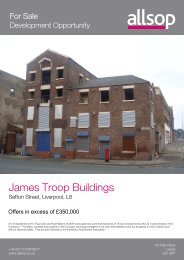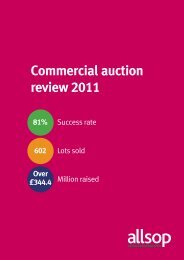Download - Allsop
Download - Allsop
Download - Allsop
You also want an ePaper? Increase the reach of your titles
YUMPU automatically turns print PDFs into web optimized ePapers that Google loves.
Shoreditch developments<br />
History<br />
1 - Principal Place<br />
Planning consent has been granted for a Foster<br />
& Partners designed office building of 55,742 sq M<br />
(600,000 sq ft) with 4,180 sq m (45,000 sq ft)<br />
floor plates. The scheme also incorporates a 52<br />
storey residential tower.<br />
Developer: Brookfield<br />
Architect: Foster & Partners<br />
2 - The Stage<br />
A planning application will shortly be submitted<br />
for a development comprising 380 residential<br />
units, 3,716 sq m (40,000 sq ft) of retail and<br />
37,161 sq m (400,000 sq ft) of offices arranged<br />
around 1.2 acres of public space.<br />
Developer: Plough Yard Development<br />
Architect: Pringle Brandon Drew<br />
− The Shoreditch Estate lies on a Scheduled Ancient<br />
Monument with the southern half of One Shoreditch<br />
within the precinct of the Priory and Hospital of St<br />
Mary Spital. The Priory and Hospital, which date back<br />
to 1197, was dissolved in 1539 under Henry VIII and<br />
largely demolished or adapted to secular uses.<br />
− The 17th Century saw an influx of Huguenots and the<br />
area’s historical association with the silk industry was<br />
established.<br />
− The late 17th and 18th Centuries saw the development<br />
of Georgian terraced housing to accommodate the<br />
master weavers controlling the silk industry. However<br />
periodic crises in the silk industry brought on in part by<br />
cheap French imports and The Spitalfields Riots led to<br />
the downturn in the silk market.<br />
− By the Victorian era the silk industry had entered a<br />
period of long decline and Spitalfields became a<br />
byword for urban deprivation. Commercial uses came<br />
to predominate the area with houses replaced by<br />
warehouses and workshops. The Spitalfields Fruit and<br />
Vegetable market dominated the area in the late 19th<br />
and early 20th Century.<br />
− From the 1960s onwards a “new Georgian” ethos lead<br />
to campaigns to save the old merchant terraces and<br />
a gentrification of the area commenced. Urban<br />
regeneration has seen the erection of large modern<br />
office blocks as well as the preservation of Old<br />
Spitalfields Market since 1991 when the Fruit and<br />
Vegetable Market moved to Leyton.<br />
− As well as the commercially led regeneration of the<br />
area, it has become well known for its arts and music<br />
scene, which combined with the vibrant environment,<br />
has attracted a new and diverse occupier base of<br />
technology, media and telecoms companies to the area.<br />
Tech City<br />
− In November 2010 David Cameron set out the<br />
Governments ambition to help East London become one<br />
of the world’s great technology centres by supporting<br />
the existing cluster of organisations in the area.<br />
<br />
“It’s clear that in East London we have the potential<br />
to create one of the most dynamic working<br />
environments in the world”.<br />
David Cameron, Prime Minister – November 2010<br />
3 - The Fruit & Wool EXCHANGE<br />
planning consent was recently granted for a<br />
development which will provide 36,232 sq m<br />
(390,000 sq ft) of office accommodation, 2,694 sq M<br />
(29,000 sq ft) of retail and restaurants, a public<br />
house and over 1,997 sq m 21,500 sq ft of<br />
dedicated SME space.<br />
Developer: Exemplar and City of London<br />
Architect: bennetts associates<br />
4 - Bishopsgate Goods Yard<br />
Bishopsgate Goods Yard is an important strategic<br />
site of 4.7 hectares (11.614 acres). The future<br />
of the site could provide up to 2,000 new homes,<br />
offices and 1.7 hectares (3.459 acres) of open<br />
space for the local community.<br />
Developer: Ballymore and Hammerson<br />
− With 3,200 new IT start ups in the last four years,<br />
London’s Tech City has grown exponentially and now<br />
employs approximately 48,000 people.<br />
− A number of large multi-national companies including<br />
Cisco, Facebook, Google and Vodafone have invested<br />
in the technology hub, with Google opening an<br />
Innovation Centre, Vodafone bringing its Ventures<br />
Investment Fund and Amazon opening a Digital Media<br />
Development Centre.<br />
10<br />
Shoreditch Estate, London E1<br />
11
















